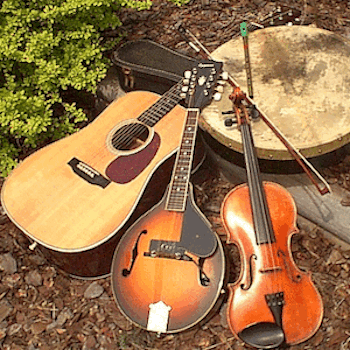Learning to play Irish acoustic guitar is a wonderful journey. Whether it is a jig, reel, slip jig or a hornpipe, it is almost certain that toes will be tapping and bodies swaying when those infectious rhythms get moving. While these songs were originally made for fiddle, whistle and pipes, you can learn to play them on the guitar. Irish, or any Celtic folk music, has the distinctive beat and rhythm that is at once primal and yet somehow almost spiritual; read on…

Acoustic Instruments To Play Celtic Music
Maybe it is the Celtic soul coming out in the tunes that makes them so enchanting. Playing these tunes with other musicians is totally enjoyable and provides ample opportunity for improvisation and ornamentation.
The easiest way to begin playing traditional Celtic,Irish and Scottish music is to learn the chords and rhythms. Once you get the hang of the reels, jigs, airs and hornpipes, you will be able to figure out other songs with relative ease.
Masterguitarguide.com is reader supported. If you make a purchase through any of the links inside this post we might receive a small commission.
Recommended Instruction
One thing that is different is the use of flatted notes, such as the 7ths. This can be a bit confusing at first, because it is different than traditional western music. When the 7th is flatted, it is called the Mixolydian mode. This gives the music that haunting sound, tinged in loneliness and thoughtfulness.
For example: in the key of D (very popular, by the way), the notes would be D,E,F#,G,A,B,C. The difference between a “normal†D scale and the Mixolydian Mode or scale is simply the one note: C instead of C#. The way I figure it is that anything that endures for hundreds of years simply can’t be that complicated, otherwise your average person couldn’t learn it and pass it down.
Irish music was not made for guitar
The reason there are very few rules, such as chord changes and just how to learn the difference between a jig, reel, strathspey, slip jig and slide is because there are very few rules.
Playing any Celtic music on guitar is all about sentiment, feel and playing creatively. If you are stuck in a mechanical rut, the music will sound boring and uninspired.
One of the best ways to learn how to play jigs, reels and airs on acoustic guitar is simply to listen to a lot of Irish music played on the guitar.
One of the best players anywhere is John Doyle, from Dublin. He learned by trial and error and has developed into one of the finest to be heard anywhere.
His playing is a good example of playing from the heart, but at the same time, he is quite accomplished technically. One curious aspect is that he is left handed and this has caused him to learn in a rather unorthodox manner.
Why bluegrass players struggle with Celtic guitar

Old Irish Castle
Most flatpicking is done by using the down-up, down-up method. This works great for tunes in 4/4 time, but when a tune has extensive triplets you need to use a different method: down-down-up, down-down-up. Or, my preferred method, is to still use down-up-down-up, but emphasis the changing emphasis in 3/4 or 6/8 time. I find the down-down-up method difficult at faster tempos, though it is nice to use both in the same tune for the sake of variety.
This requires a little re-wiring of the brain and hand, but it is worth the effort. Not only will you be able to play the traditional acoustic Irish music, but it will enhance the rest of your playing as well.
Bluegrass has it’s roots in Celtic music and has developed over time into the amazing genre that it is. Very often you can hear the exact same melody in a Celtic tune and a bluegrass tune played quite differently. Here is a wonderful example done by Alisdair Fraser and Natalie Hass. It’s fiddle and cello, no guitar, but shows the evolution from Scotland to Ireland to Appalachia.
One difficulty bluegrass encounter is that the chord changes in Celtic music are seemingly random, especially compared to traditional bluegrass I,IV, V chord changes. This can be overcome by listening and forgetting what you think you already know.
Tony McManus is a good example of a very good Scots guitarist who is creative, yet stays within the traditional structure of the tune. He plays fingerstyle, which lends itself nicely to quieter tunes, such as airs. You can find one of his recordings here:Â The Maker’s Mark: the Dream Guitar Sessions
How to learn Celtic Irish music on guitar
Unless you are especially clever, you will need some tablature or written music to follow. A better method is to learn from a fiddler, but not everyone has that option. You can also figure it out from recordings, which works great as well.
The first thing is to learn the melody so you can whistle, hum or sing it. This makes all the difference and will greatly speed up the process and make it sound like music instead of notes. Acoustic Irish guitar music is quite improvisational and can be played more than one way correctly.
Next, break the song up into phrases and learn them one at a time. You will see that most tunes are made up of an A and B part, and sometimes a C part. Typically these all repeat once then move to the next part, and return back to the A part; as in AA, BB.
Recommended Listening
| Masters of the Irish Guitar |
| Best of Altan: The Songs |
| John Carnie: Far From Home |
It is far easier to learn if you can sing the melody and play the chords along with a recording or a friend. Once you get the song in your head you can begin with the melody, there are only so many notes to choose from. Most Celtic Irish music is rather simple in essence, but do not be fooled by that!
Use a metronome and play it slower and slower until you think you cannot go any slower.
Then reverse the process and play it faster and faster until you crash. Go back a bit and repeat this process until you can play it. If you do this over a period of time, you will never forget the fingering and melody.
Try holding the pick differently so you can strum fast
It is a good idea to begin with reels, since they are in 4/4 time and are easier to play than a jig, for example. Practice the strumming in a new way.
That is, lighten up on the pick, a lot, almost until it falls out of your hand. Hold it differently also. Hold it with two fingers underneath and the thumb on top.
Relax and you can learn to play Irish music on acoustic guitar
Strum with your forearm, not your entire arm or the wrist. Imagine your thumb to be one with your forearm and strum hard. You will discover that a softer pick works much better as well. Because you are holding the pick so lightly, the sound will not be harsh, even though you are strumming forcefully.
Try damping the strings as well with the heel of your hand. Vary the damping with open strumming to achieve a varied and ever-changing sound. Once you learn how to play Irish music on acoustic guitar you can try the subtleties of timing, rhythm and melody.
Alternate tunings
A favorite tuning of most Irish guitarists is drop D. This is great because it gives the ringing, drone sound to the playing, plus it opens up many new chord possibilities. Chord changes in Celtic music are not written in stone, which makes if a little harder to learn Irish music on acoustic guitar.
Very often the chords used are only partial chords, and only some of the six strings are strummed. This also adds a special flavor, such as a droning D string that is always ringing in the background.
Jigs are usually more difficult, but also very interesting and fun to play. The 6/8 timing causes many people headaches because the strumming is still comprised of down/up strums.
Strumming is essential to learn how to play Irish music on acoustic guitar
There are numerous ways to handle this, but one common method is to play down/up/down/down/up/down/down/up/down/up. It is somewhat awkward to begin with, but with practice you will quickly see the advantages of this type of strumming.
Listen to fiddle tunes, guitar accompaniment, and even pipe tunes. There are many excellent traditional bands around that have awesome interpretations of great Irish, Scottish and other Celtic tunes.
Recommended Listening
| Masters of the Irish Guitar |
| Best of Altan: The Songs |
| John Carnie: Far From Home |
A few good bands to listen to include: Altan, Clannad, Solas, Natalie MacMaster, Dervish, Capercaillie, Silly Wizard, and The Battlefield Band. Listening a lot will really help to learn how to play Irish music on acoustic guitar.
Celtic Guitar Courses, Books & DVDs on Amazon
Irish Guitar Lesson on Youtube
More about learning how to play guitar
Download Guitar Courses help you learn at your own pace, in the comfort of your home. Get 24/7/365 access now to really start learning how to play guitar.






 Sign up to receive a free ebook: Master The Guitar in 7 days! (available for a limited period)
Sign up to receive a free ebook: Master The Guitar in 7 days! (available for a limited period)